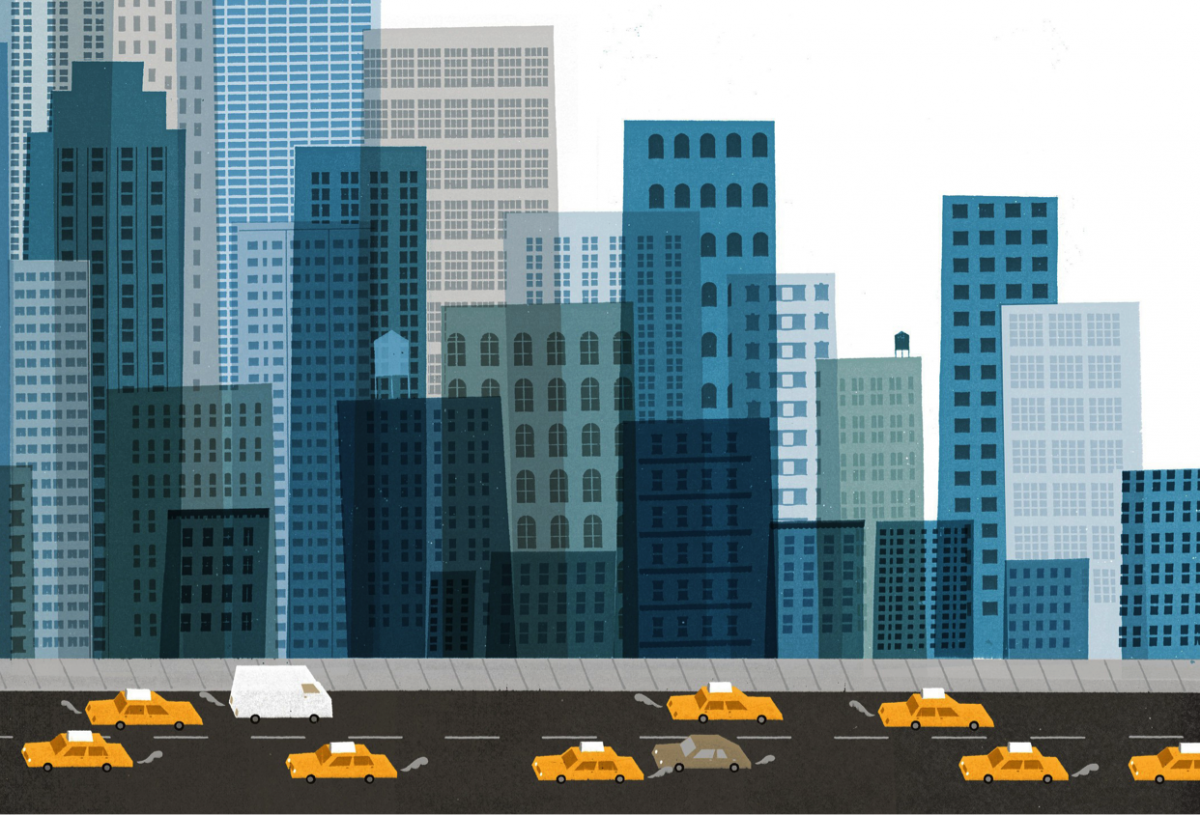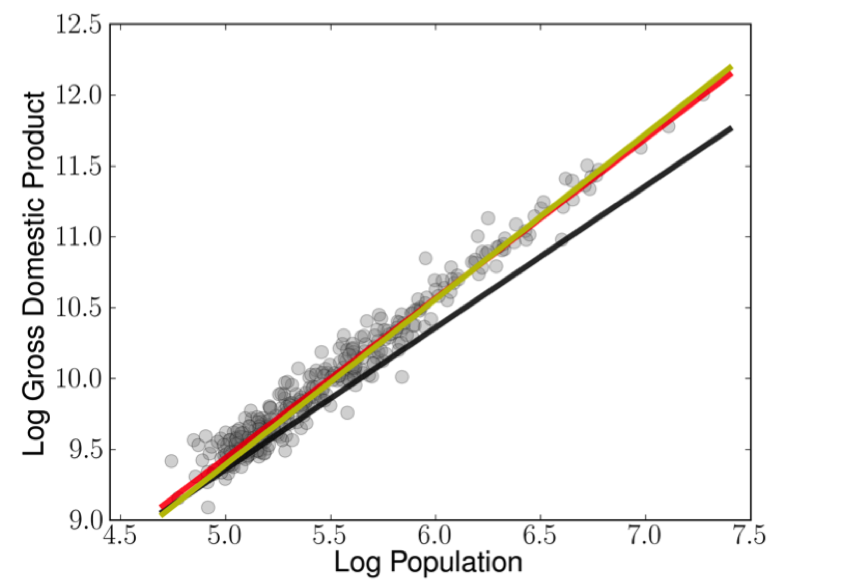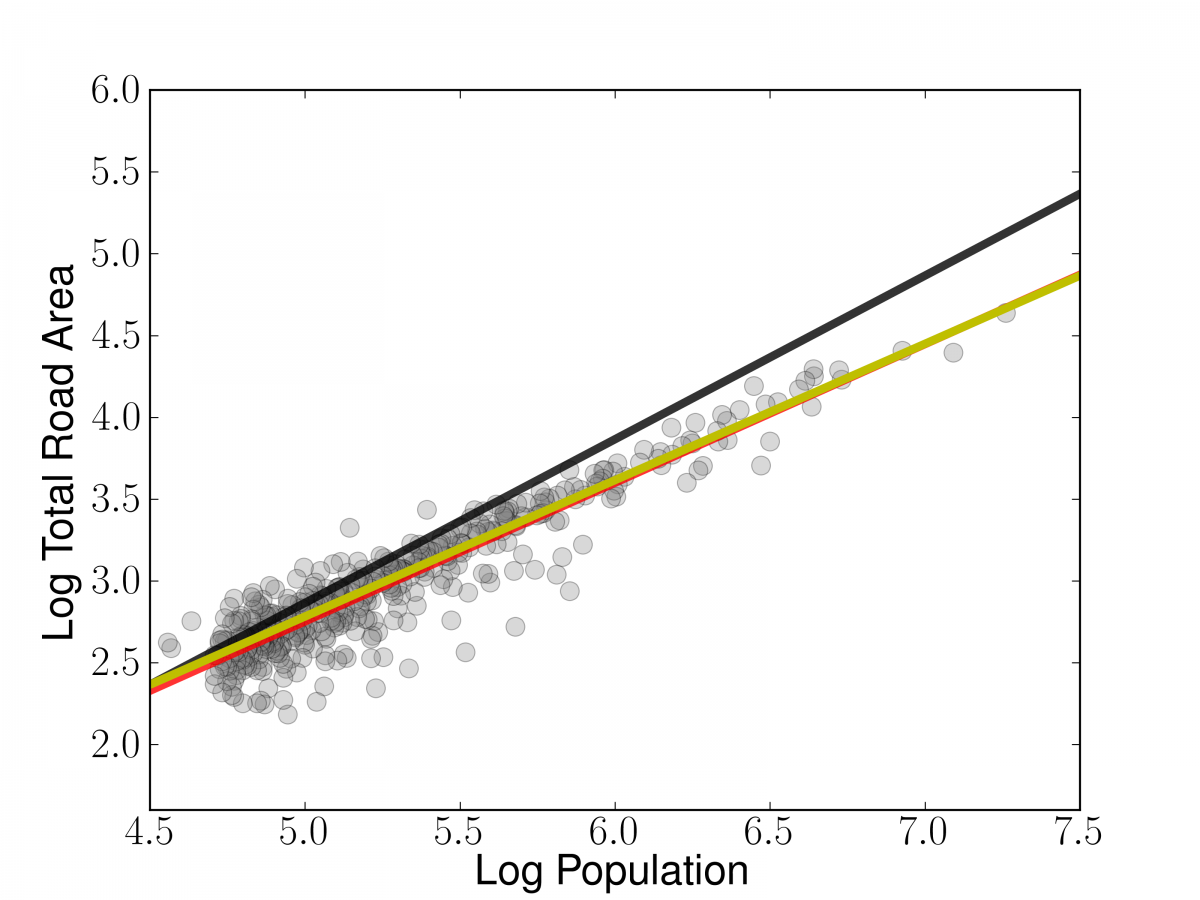
Cities exist - historically and around the world - across an immense range of sizes and spatial forms. From the regular grids of old roman camp towns and contemporary American cities to the curvy mazes of medieval European burgs, from Venice with its canals to the organic explosive growth of Lagos or Jakarta, there are an almost endless number of ways of being a city1 2.
But despite this mesmerizing diversity of size and form, certain subtle patterns recur as a sort of coda common to all cities. These properties are very familiar but their quantitative expression and implications are only now being revealed by large-scale empirical scientific studies that use comparable data across many different cities.
The central results from these studies3 4 stress the importance of scale effects in cities.
Larger and smaller cities are not the same, of course, even when observed locally, from the perspective of specific places or individuals. However, sliding the scale of city size by comparing a number of cities with different population magnitudes allows us to observe how certain properties of urban areas, such as the extent of their infrastructure, land area and the productivity of their economies, changes continuously and systemically7." href="#ref17">17. We also learn to see how such changes can be observed not only in cities as a whole, but also in each of their parts.
In order to appreciate this we need to develop general metrics. These are quantities that can measure the extraordinary complexity of cities across as many dimensions as possible, but that are also applicable through time and for places with different levels of wealth, infrastructure or technology.
The simplest such metrics account for the size of cities. We most commonly think of the size of an urban area in terms of its population; but we could also define it in terms of their spatial extent (as a land area) or the extent of their economies (as Gross Domestic Product, or GDP).
For simple systems in physics such as gases and liquids, measures of size are proportional to each other. For example, for an ideal gas the total volume, energy or entropy are proportional to the number of particles. Such systems are called extensive8. Their densities are uniform and featureless across space and time, and characterize the bulk properties of a material, such as its temperature, particle density, or chemical potential.
Not so with cities. Cities are immensely heterogeneous with different people and different places containing different information and specializing in different functions. This heterogeneity makes cities non-extensive systems and requires a different theoretical framework: cities are complex adaptive systems.

General scale effects in cities
What is interesting is that the complex structure and dynamics of cities display simple scale effects as its main signature. These effects give us an entry point to study cities scientifically, and also to frame practical problems of policy in urban areas. Scale effects come in two forms affecting different quantities: these are known as increasing returns to scale and economies of scale4.
These two terms have a long history in economics7 and organizational theory9: they have a somewhat different meaning in the context of cities because, as we shall see, they express the same underlying dynamics related to the embedding of socioeconomic networks in built space.
The first type of effect - increasing returns to scale - tends to get most of the attention because it accounts for the socioeconomic advantages of larger cities and of more urbanized societies more generally.
Economists have noticed empirically7, at least since the 1970s, that many economic quantities in cities, such as wages (the price of labor), value added in production (corporate profits) and the size of the entire economy (GDP) are all greater per capita in larger cities when compared to smaller towns in the same nation 18.
More qualitatively, observations of this sort of effect go back to economic studies during the industrial revolution in England, by Adam Smith10, Alfred Marshall11 and others. It turns out that this amplification of performance with city size not only applies to economic quantities but to most socioeconomic activity3 4. On the bright side, it leads to faster innovation and productivity in larger cities. On the darker side, it also applies to some unsavory business, such as higher rates of violent crime per capita and challenges to public health, especially related to contagious diseases.
All these effects can be traced to the kind of network effects cities realize, an issue that has only become appreciated with the recent rise of technology in the last few decades12. A familiar illustration, originally developed for telecommunication networks, is Metcalfe’s Law. It states that a network’s value is proportional to the number of its connections, not of its nodes. This turns out to be true very generally, and to apply to cities in particular.
But before we can quantify the origin of network effects in cities we must consider space. Space provides the most obvious example of economies of scale in cities.
Urban space is itself complex as it is made up of built structures such as places of work and residence, which are connected by infrastructure networks, such as streets and roads. In modern cities, other infrastructure types such as water and sanitation pipes, electrical cables, optical fiber, etc also play a role. The built space of cities can be realized following many shapes, but the essential property is that all places are connected by decentralized networks of infrastructure that allow point to point movement3.
What is interesting about urban built space is that when it is analyzed for scaling effects, it behaves in the opposite way to socioeconomic quantities: the amount of built space, used by buildings and by infrastructure networks decreases per capita with the population size of the city. This is somewhat familiar, as we experience generally higher population densities, greater congestion and crowding in larger cities.

These higher densities produce a number of opportunities for other savings. Greater density means that people’s movement can be aggregated, and public transportation becomes possible and economically viable. Space must also be used more intensely, with the result that buildings tend to become larger and taller, thus creating potential scale efficiencies in the use of energy and materials. This means in general that local energy consumption in larger cities is smaller per capita – both in transportation and in buildings. It also makes the incubation of new and more expensive businesses and technological solutions possible because they can tap on a larger client base over the same amount of time. This means that more specialized services can exist in larger cities, leading to other efficiencies related to the division of labor and knowledge10 13.
Spatial economies of scale mirror socioeconomic network effects
Spatial economies of scale and socioeconomic effects of cities are not random, but intimately related to each other. In a specific sense, they are each other’s mirror image3.
Population density is often misunderstood. Large residential densities, for example, are not necessarily a good indicator of greater economic performance. What matters for a city is a high density of (positive) social connections over space and time. Such connections are facilitated by higher population densities in built space, but also show certain rhythmic and transient effects as people commute to work, and participate in varied activities within an interacting and diverse socioeconomic system.
These dynamics and, in particular, the density of connections that cities create can be estimated through knowledge of the population and built up areas in a city3. In this sense, less space per capita in urban public spaces is simply a greater likelihood of social interaction. It is the statistical result of this larger number of interactions that creates great urban socioeconomic productivity per capita in larger cities. Thus, spatial economies of scale are an expression of more intense network effects and vice versa.
We now also see in what sense we can talk about economies of scale in cities relating to space and infrastructure: larger cities can do more (economically) with less (space and infrastructure): this is somewhat analogous to economies of scale in a manufacturing firm, though in this case such economies tend to relate to the cost of producing a certain volume of standardized output. The magic of cities is that their scale effects are much more general and apply to any kind of socioeconomic output.
Scale effects allow us to appreciate that cities of different sizes also have different problems and that such problems tend to require different policy approaches. As we saw, densification and network scale effects mean that larger cities are denser and more congested and that their infrastructure is used more intensely, requiring greater resilience and repair. These costs actually offset much of the advantages of larger cities and make life in urban areas of different sizes an approximately neutral proposition 19. The essential tradeoff is between a more intense socioeconomic life in less space and at greater cost in larger cities, versus a quieter and less diverse life that is cheaper but that affords more space and tranquility in smaller towns. People tend to explore these tradeoffs to their own advantage not only as a function of personal preferences but also throughout their lifecycle.
What then is the point of cities? What accumulates in the city or system of cities that is not accounted for by the daze of the daily rat race?
Heterogeneity, change and development
The answer to this kind of question permits a new perspective on the ultimate function of cities in human societies. Urban life facilitates the sort of growth in collective knowledge that is the basis of economic growth and human development14. While it is possible to have cities without economic growth, urbanization seems to be a necessary condition for fast and consistent development in any human society. We see these processes go hand in hand around the world today, though not always smoothly, as billions of people increasingly choose to live in cities.
The expansion of network effects per capita leads to a very practical outcome that in larger cities people become more interdependent. This means that each individual can obtain more services from others but also that, as a consequence, she experiences a greater pressure to specialize and learn how to do certain jobs better but also more narrowly. This process creates deeper new knowledge, and more opportunities to combine that knowledge. On average, this process leads to greater economic value per unit of labor, while creating new technologies and organizations that can spread15. Thus, spatial economies of scale are intimately connected to thicker socioeconomic relations and with deeper knowledge, which can be networked to create new solutions and opportunities.
It is this process of specialization that also creates greater local diversity in cities. By needing to find social and economic niches, people and organizations also create diversity. Like everything in cities, this diversity has its dark manifestations, such as economic inequality, and can self-destruct if opportunities to connect and create new knowledge and human capital are barred from some segments of the population.
The process of development of entire cities and nations retraces some of these individual dynamics. In poorer nations, we observe immense cities being created for which there is a relatively low level of quantitative information, especially in the poorest parts of the world in Asia and Africa. The expectation is that despite large populations, these cities have only started to explore the network effects and knowledge creation that are latent in their size16. To do that well, they will need to also create the spatial organization, infrastructure and social institutions that allow millions of strangers to work together in positive ways, by inspiring general trust and a sense of excitement not only in sharing the same common ground, but a common future full of new possibilities.
The true role of economies of scale in cities is in facilitating and enabling this expansion of human socioeconomic interactions. This requires an eye to the functional role of built spaces, as enabling and multiplying urban network effects in ways that are now increasingly measurable, but that we are just starting to understand in detail.









